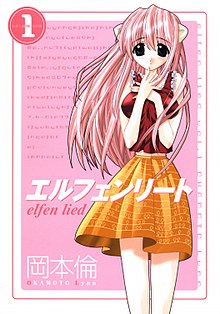Elfen Lied
| Elfen Lied | |

First tankōbon volume of Elfen Lied, released in Japan on October 18, 2002 by Shueisha, featuring the main character Lucy.
|
|
|
エルフェンリート (Erufen Rīto) |
|
|---|---|
| Genre | Psychological horror, Romance, Science fantasy |
| Manga | |
| Written by | Lynn Okamoto |
| Published by | Shueisha |
| Demographic | Seinen |
| Magazine | Weekly Young Jump |
| Original run | June 6, 2002 – August 25, 2005 |
| Volumes | 12 |
| Anime television series | |
| Directed by | Mamoru Kanbe |
| Written by | Takao Yoshioka |
| Studio | Arms |
| Licensed by | |
| Original network | AT-X |
| English network | |
| Original run | July 25, 2004 – October 17, 2004 |
| Episodes | 13 |
| Original video animation | |
| 10.5: Regenschauer | |
| Directed by | Mamoru Kanbe |
| Written by | Takao Yoshioka |
| Studio | Arms |
| Licensed by | |
| Released | April 21, 2005 |
| Runtime | 25 minutes |
Elfen Lied (エルフェンリート Erufen Rīto?) is a Japanese manga series written and illustrated by Lynn Okamoto. It was originally serialized in Shueisha's Weekly Young Jump from June 2002 to August 2005, with the 107 chapters collected into twelve tankōbon volumes. Elfen Lied revolves around the interactions, views, emotions, and differences between human beings and the Diclonii, a mutant species similar to humans in build but distinguishable by two horns on their heads and "vectors", transparent telekinetically controlled arms that have the power to manipulate and cut objects within their reach. The series is centered on the teenage Diclonius girl "Lucy" who was rejected by human beings and subsequently wants revenge.
The series' title is German as well as Dutch for "Elves' Song" or more formally "song of the elves'" and takes its name from the song "Elfenlied", which is featured in the story. Elfen Lied involves themes of social alienation, identity, prejudice, revenge, abuse, jealousy, regret and the value of humanity. It is also noted for the graphic violence, emotional themes of how the characters change through, and the overall transgressive subject matter of the whole story. A 13-episode anime television series adaptation was produced by the studio Arms and broadcast on AT-X from July to October 2004. The anime began airing before the manga was complete; as a result, the plot differed between the two, especially the ending. The anime series has been licensed in North America by ADV Films and in Australia by Madman Entertainment. ADV Films said the series was one of their bestselling and "most notorious" releases of 2005. The Anime Network is streaming the series in English, German, and French.
...
Wikipedia
